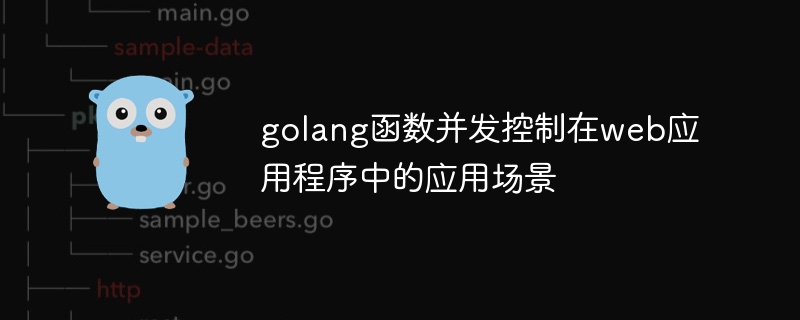Home >Backend Development >Golang >Application scenarios of golang function concurrency control in web applications
Application scenarios of golang function concurrency control in web applications
- WBOYWBOYWBOYWBOYWBOYWBOYWBOYWBOYWBOYWBOYWBOYWBOYWBOriginal
- 2024-04-24 21:42:01802browse
In Web applications, the function concurrency control of Go language can realize the following scenarios: parallel processing of high-concurrency HTTP requests to avoid blocking of synchronous processing; parallel execution of time-consuming tasks to improve performance; use of Goroutine pool to efficiently manage Goroutine, Improve concurrent application performance and scalability.

Application scenarios of Go language function concurrency control in Web applications
In Web applications, concurrency control is effective for Handling parallel requests is critical. Concurrency features in the Go language provide powerful tools to manage this scenario. The following are some practical examples of functional concurrency control in web applications:
Handling high concurrent HTTP requests
package main
import (
"fmt"
"net/http"
)
func main() {
http.HandleFunc("/", func(w http.ResponseWriter, r *http.Request) {
fmt.Fprintf(w, "Hello, World!")
})
http.ListenAndServe(":8080", nil)
}By default, HTTP requests are processed synchronously , which means that each request blocks subsequent requests. By using Goroutine (a concurrent execution unit), we can process requests in parallel:
package main
import (
"fmt"
"net/http"
"sync"
)
var wg sync.WaitGroup
func main() {
http.HandleFunc("/", func(w http.ResponseWriter, r *http.Request) {
wg.Add(1)
go func() {
defer wg.Done()
fmt.Fprintf(w, "Hello, World!")
}()
})
http.ListenAndServe(":8080", nil)
wg.Wait() // 等待所有 Goroutine 完成
}Perform time-consuming tasks in parallel
Sometimes, a web application needs to perform time-consuming tasks time-consuming tasks, such as data processing or file uploading. These operations can be executed concurrently to improve performance.
package main
import (
"fmt"
)
func main() {
ch := make(chan int)
go func() {
// 执行耗时的任务
result := doSomething()
ch <- result // 将结果发送到通道
}()
result := <-ch // 从通道接收结果
fmt.Printf("耗时任务的结果:%d", result)
}Using Goroutine Pool
Goroutine pool is an efficient way to manage Goroutine, avoiding the overhead of frequent creation and destruction of Goroutine. This helps improve the performance and scalability of concurrent applications.
package main
import (
"fmt"
"sync"
)
var pool = sync.Pool{
New: func() interface{} {
return &Goroutine{}
},
}
type Goroutine struct {
id int
}
func main() {
for i := 0; i < 10; i++ {
g := pool.Get().(*Goroutine)
g.id = i
go func(g *Goroutine) {
defer pool.Put(g) // 释放 Goroutine
// 执行任务
fmt.Printf("Goroutine ID:%d\n", g.id)
}(g)
}
fmt.Println("所有任务执行完毕")
}By applying functional concurrency control in web applications, we can improve performance, increase scalability, and enhance the application's ability to handle parallel requests.
The above is the detailed content of Application scenarios of golang function concurrency control in web applications. For more information, please follow other related articles on the PHP Chinese website!
Related articles
See more- How to compare strings for equality in golang
- Tutorial: How to make a weather web application using JS and API (Collection)
- Flask-Login: User authentication in Python web applications
- Java Security: How to Protect Web Applications from Attacks
- Concurrency control and lock mechanism in PHP database connection

